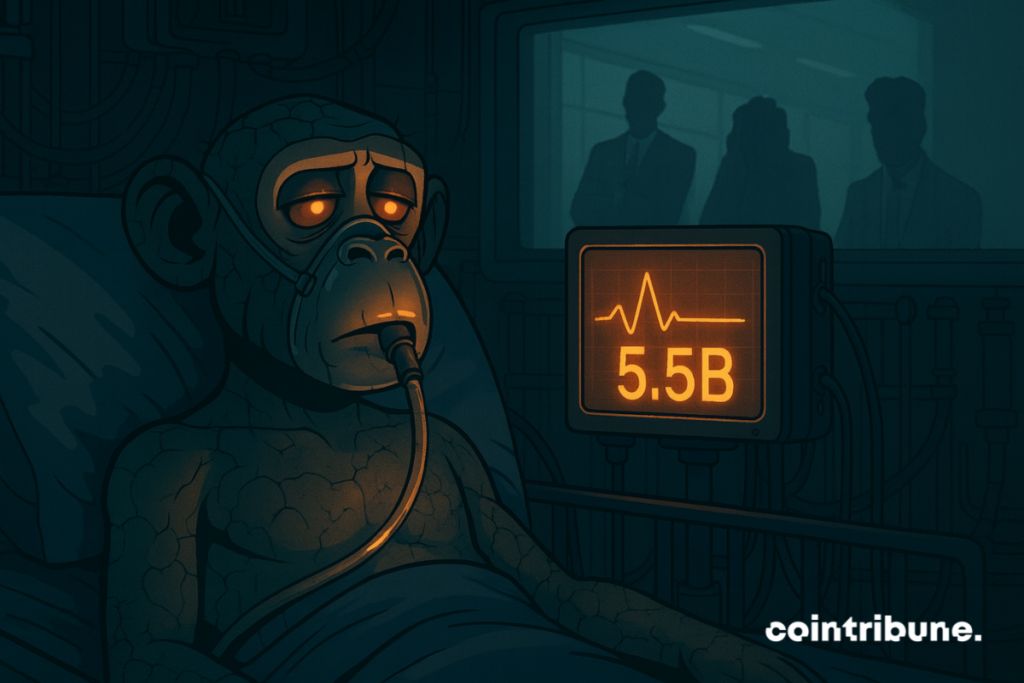NFT Market Tries to Recover After $1.2 Billion in Losses
After a lightning plunge of $1.2 billion, the NFT market is attempting a comeback. Signs of recovery are multiplying, though uncertainties remain. Should this be seen as a mere bounce or a true renewed interest in digital assets? Full analysis here.

In brief
- The NFT market lost $1.2 billion in 24 hours, revealing its strong sensitivity to crypto volatility.
- Despite a partial recovery, only a few collections are holding up.
NFTs Dragged Down by the Crypto Market Crash
Last Friday, the crypto market faced a significant drop. The bitcoin price plunged to $102,000, in a climate weighed down by the announcement of trade sanctions between the United States and China. This shock triggered a wave of liquidations reaching $20 billion.
Like many other digital assets, NFTs took the full brunt of the impact. In 24 hours, sector capitalization fell from $6.2 to $5 billion, according to CoinGecko data . This 20% drop reveals the market’s structural dependence on crypto volatility and sudden liquidity drying up.
Timid Recovery of the NFT Market and Partial Confidence
By Sunday, a slight rebound started. NFT capitalization briefly reached $5.5 billion before falling back to $5.4 billion. Some see this as a return of risk appetite. That said, the numbers remain mixed:
- historical collections like Bored Ape Yacht Club fall by 10.2% over seven days;
- Pudgy Penguins drop 21.4%;
- CryptoPunks give up 8%.
Only a few projects like Hypurr NFTs (+2.8%) or Mutant Ape Yacht Club (+1.5%) show a timid green. This reflects a more selective trend. It means buyers are scrutinizing fundamentals more and shunning overvalued collections.
Institutional Capital, a Shield Against Panic?
Despite the correction, institutional crypto products held firm. According to CoinShares, crypto ETPs recorded $3.17 billion in weekly inflows. This positive NFT flow stands in contrast with the markets’ bloodletting. More importantly, it signals long-term conviction among some players.
The question remains whether these investments truly support NFTs or focus on the BTC/ETH duo. The contrast with retail volatility highlights a strategic gap. NFTs, often seen as highly volatile assets, could come out stronger from this period if they demonstrate more than just a fleeting trend.
Despite some recovery signals, the NFT market still has to prove its resilience. The coming months could mark a turning point!
Disclaimer: The content of this article solely reflects the author's opinion and does not represent the platform in any capacity. This article is not intended to serve as a reference for making investment decisions.
You may also like
Risks and Insights from the COAI Token Fraud: A 2025 Handbook for Cryptocurrency Due Diligence and Safeguarding Investors
- COAI Token's 2025 collapse caused $116.8M losses, exposing systemic risks in algorithmic stablecoins and centralized governance. - Project's 96% supply concentration in ten wallets, opaque team identities, and weak tokenomics flagged regulatory red flags. - Global regulators froze $150M in assets but exposed jurisdictional gaps, while EU and US introduced crypto frameworks with conflicting standards. - Investors now prioritize AI audits, multi-sig wallets, and KYC compliance to mitigate risks in speculat

COAI's Unexpected Downturn in Late 2025: A Warning Story on AI Stock Valuations and Governance Risks
- COAI Index's 88% YTD drop highlights systemic risks in speculative AI equities and crypto assets amid strong AI infrastructure growth. - C3 AI's Q3 revenue growth contrasts with non-GAAP losses, underscoring AI sector's profitability challenges vs. disciplined tech peers like Benchmark Electronics. - CLARITY Act's regulatory ambiguity and EU AI Act compliance costs deter institutional investment, exacerbating COAI's governance and liquidity issues. - COAI's "fake decentralization" and C3 AI's leadership

Vanguard opens platform to Bitcoin ETFs and ends two-year blockade

3 Strong Altcoin Picks Showing Clear Growth Momentum — GIGA, ALGO, and NOT

